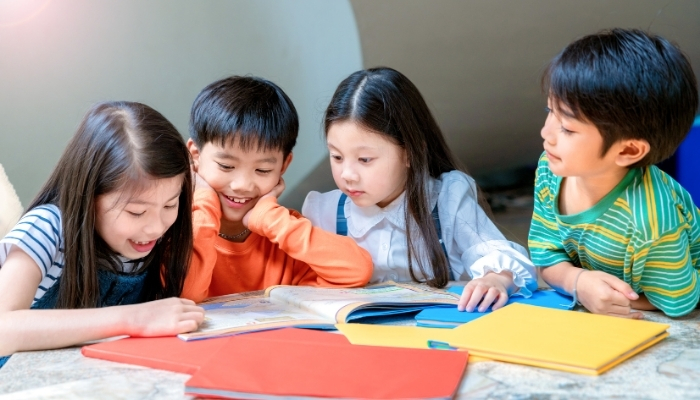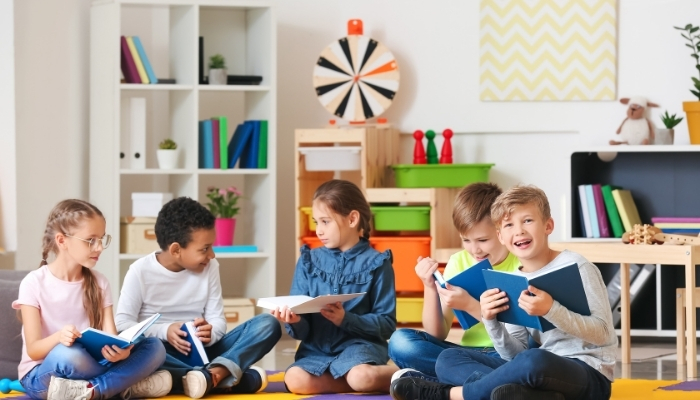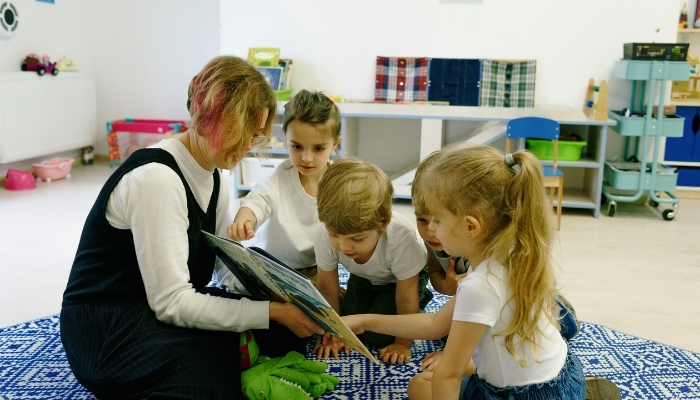You notice your child sounding out the same simple words over and over. Each letter gets careful attention, yet its reading still feels slow and choppy. It can be frustrating to watch, and you may worry whether your little one is falling behind their peers.
You are not alone. Many parents see this and wonder how to help their children. Kindergarten reading fluency develops at different rates, and struggles at this stage are entirely normal. With the proper guidance and practice, your child can gain confidence and start reading more smoothly.
Focusing on building reading fluency at home can make a meaningful difference. By using targeted strategies and engaging activities, you can help your child develop accuracy, pace, and expression while keeping reading enjoyable.
This guide will help you understand what typical reading fluency looks like for kindergartners, why some children face challenges, and practical ways to support your child’s growth as a confident reader.
Key Takeaways
-
Kindergarten reading fluency develops at different rates, and early struggles are everyday and temporary.
-
Building fluency involves accuracy, natural pace, expression, and confidence, not just speed.
-
Simple daily activities and playful reading routines can make practice enjoyable and effective.
-
Breaking text into phrases, repeated reading, and interactive games help children read more smoothly.
-
Consistent encouragement and positive experiences strengthen both skill and a love for reading.
What Kindergarten Reading Fluency Means?
Reading fluency refers to a child's ability to read a book or other text accurately, at a reasonable speed, and with appropriate expression. A fluent reader doesn't have to stop and "decode" each word and can focus attention on what the story or text means. For kindergartners, this looks very different from fluency for older children.

Your kindergartner shows early fluency when they recognize some words automatically. They don't need to sound out every single word in familiar books.
Here’s what reading fluency typically includes for kindergarteners:
1. Comfortable Reading Speed: Many kindergartners read between 6 to 20 words correctly per minute. Some may start with just a few words per minute and gradually increase as they practice. Slow reading at this stage is entirely normal.
2. Word Recognition Skills: Your child begins to recognize common sight words like the, and, and can do so automatically. They’ll also start noticing patterns in words; for example, if they know 'cat,' they can often figure out 'bat' or 'hat' more easily.
3. Reading With Expression: Kindergartners start to read with a natural “voice,” using slight pauses at sentence endings or minor changes in tone for characters. Even small attempts at expression are a sign of growing fluency.
4. Comfort With Familiar Texts: Confidence grows when children re-read books they know well. Each repetition makes reading smoother, faster, and more enjoyable. This familiarity lays the foundation for tackling new, slightly more challenging books.
Fluency at this stage is less about speed and more about accuracy, expression, and confidence. Parent involvement during the early years is a strong predictor of later reading success. Your support now lays the groundwork for their years of strong reading habits.
Also Read: Kindergarten Reading Level Guide and Tips
Why Some Children Struggle with Fluency in Kindergarten?
One of the most common reasons kindergartners struggle with fluency is limited exposure to books and reading. Children who haven’t been read to regularly may not have internalized the rhythm, pace, and flow of fluent reading. Without hearing language modeled often, it’s harder for them to sound natural when they read aloud.
Of course, that’s not the only factor. Several other challenges can affect fluency at this age:
-
Smaller vocabulary base: When kids run into unfamiliar words, they slow down to figure out both pronunciation and meaning. This split focus interrupts the flow of reading.
-
Letter and sound confusion: Many children still mix up letters like b and d. Until these connections are solid, smooth reading is difficult.
-
Differences in processing speed: Some children naturally require more time to process information. They may read slowly at first, but with practice, they usually catch up just fine.
-
Focus and attention challenges: Reading demands sustained attention, which can feel overwhelming for young learners still developing concentration skills.
But all of these hurdles are normal and temporary. With steady support and patience, most children overcome them and grow into fluent, confident readers.
To equip yourself with practical strategies, let’s move on to the next section, where we’ll explore practical ways you can guide your child at home through this stage.
Also Read: How to Improve Your Child’s Reading Skills
Strategies to Improve Reading Fluency in Kindergarten
Helping your child build reading fluency doesn’t need special training or costly resources. The most effective strategies utilize books you already have and integrate seamlessly into your daily routine.

Consistency is key. Start with one or two approaches that feel easy for your kid, and as they grow more comfortable, gradually introduce others to maintain steady and enjoyable progress.
1. Partnered Repeated Reading with "Echo + Stretch"
This is like echo reading, but with a twist.
-
You read a sentence (or short phrase) at a comfortable speed, emphasizing phrasing and expression.
-
Your child “echoes” the same sentence, copying your pace and tone.
-
Then both of you re-read it one more time, slower, stretching slightly (pause, breathe) to deepen the phrasing sense.
Repeated reading builds automaticity, and the echo and stretch provide your child with a scaffold toward more natural prosody. This is based on successful fluency programs where repeated, scaffolded reading improved speed and comprehension.
2. Phrase-Chunking Practice (Parsing Text Together)
Instead of reading word by word, train your child to see groups of words (chunks or phrases).
-
Take a short, familiar line (e.g., “The cat sat on the mat.”)
-
Read it with natural chunks: “The cat | sat on | the mat.”
-
Then have your child re-read by following those phrase breaks.
-
You can also “finger swipe” under each phrase during joint reading, which helps their eyes move less and read more fluidly.
This is drawn from fluency strategies (text segmentation, phrase reading) used in literacy instruction to help students read more smoothly.
3. Audio + Print “Shadow Reading”
Let your child “shadow” a fluent reader (a recording) as they read along with the print.
-
Choose a recorded reading at a moderate speed (a narrator or audiobook).
-
Play short passages you’ve already given them in printed form.
-
The child reads along with the recording, matching pace and expression.
By following this strategy, your child will “wear the voice” of a fluent reader for a moment, internalizing rhythm and phrasing. This mirrors techniques used in class, such as “listen-and-read” or “tap-along” with fluency models.
4. “Almost-Automatic” Word Walls & Orthographic Mapping Work
Word wall building is more technical, but powerful.
-
Build a small “word wall” of 10–15 high-utility, age-appropriate words (frequent words the child encounters).
-
Use orthographic mapping to help your child link spelling, sound, and meaning for each word, rather than just memorizing.
-
Practice these words in short bursts (flash, write, use in sentences).
-
Once they move from decoding to instant recognition, fluency in connected text gets easier.
This concept (orthographic mapping) is increasingly central in literacy research; repeated exposure + mapping strengthens automatic word recognition.
5. Fluency Journals with Self-Recording and Reflection
Make fluency growth tangible and motivating.
-
Give your child a short passage (1–2 sentences).
-
Ask them to read it while you audio-record.
-
Later, the two of you listen together. Ask: “Where did you go very smoothly? Where did your voice pause too much?”
-
Have them re-record the same text a few days later and compare the results.
This encourages self-awareness of reading, helps them recognize their improvements, and adds a little “meta” layer by allowing them to reflect on their reading. It’s an application of strategies like re-reading and self-monitoring.
6. “Fluency Swaps” with Peers or Siblings
Turn fluency practice into a shared activity.
-
Pair your child with a sibling or friend (same level or slightly higher).
-
Each takes a short text. They swap and read each other's passages.
-
Then they give gentle feedback (what sounded smooth, what sounded too slow).
It is a version of partner reading (a proven fluency method) adapted for home. It gives variety, social motivation, and the feedback loop.
7. Integrate Fluency into Play: “Reader’s Theater Lite”
You don’t need complete scripts or complex setups; make short, playful performances.
-
Pick simple dialogues or short scenes (2–3 lines) from familiar books.
-
Assign roles, and have your child (or siblings) act it out, reading with expression.
-
Use simple “props” (such as a hat or stuffed toy) to make it fun.
Because children see reading tied to performance, they tend to read more naturally. This taps into expression, phrasing, and meaning simultaneously, the hallmarks of fluent reading.
You don’t need to do all these at once. Start with one that fits your child’s personality and routine. Do it regularly with awareness and with purpose. Over weeks, you’ll hear smoother, more confident reading.
Activities to Boost Kindergarten Reading Fluency
Fun activities transform reading practice from work into play for kindergartners. These hands-on experiences build fluency skills while keeping your child motivated and engaged. You can choose and match activities according to your child's current reading level and interests for the best results.

1. Fluency Hopscotch
Goal: Help your child recognize short phrases and read them without pausing excessively.
-
Draw a hopscotch path with chalk or tape. Instead of numbers, write short phrases or familiar words in each square (for example: in the park, big dog, run fast).
-
Ask your child to hop from square to square, reading the phrase aloud as they land.
-
If they stumble, pause the game briefly to re-read together, then continue.
-
You can challenge them later to hop and read without stopping.
Benefits: Connecting movement with reading encourages pacing and trains your child to group words into meaningful chunks.
2. Word-Road Rally
Goal: Encourage reading in smooth, connected phrases rather than reading word by word.
-
Write a short sentence on strips of paper, like The cat sleeps on the rug, and place them in a line on the floor.
-
Hand your child a toy car (or small figure) and ask them to drive along the “road” as they read each strip.
-
Encourage a steady pace: if they hesitate too long on one strip, pause the car and gently help them.
-
Over time, ask them to read the sentence in one breath.
Benefits: The steady “road” helps build flow, and repeated exposure helps word recognition become more automatic.
3. Poetry Freeze Game
Goal: Build anticipation, phrasing, and rhythmic reading.
-
Pick a short poem or nursery rhyme your child already knows, like “Hey Diddle Diddle” or “Humpty Dumpty.”
-
You begin reading, then randomly pause mid-line and let your child finish the rest of the sentence.
-
Switch roles: your child reads and pauses, you complete the line. As they improve, pause later in longer lines.
Benefits: Rhythm and rhyme strengthen reading rhythm; the freeze adds fun and trains pacing and prediction.
4. Sentence Puzzle Hunt
Goal: Teach your child to see sentences as connected phrases rather than a list of words.
-
Write a sentence (e.g., The puppy likes to play outside) and cut it into two- or three-word chunks (e.g., The puppy likes to play outside).
-
Hide the pieces around the room. Your child hunts for them, then arranges them in order before reading the complete sentence.
-
You can add a timer to make it more playful if your child enjoys challenges.
Benefits: Breaking sentences into meaningful chunks trains natural phrasing and strengthens comprehension as they rebuild and read the sentence.
5. Word Toss
Goal: Make repeated exposure to key words fun and unpredictable.
-
Write sight words or short phrases on paper plates and arrange them in a circle or scattered on the floor.
-
Give your child a beanbag to toss. When it lands on a plate, your child reads the word or phrase aloud.
-
To deepen understanding, ask them to use the word in a sentence. Over time, reduce tasks that require turning and sentence reading to focus more on fluid reading.
Benefits: The game format makes repetition engaging, while random selection prevents boredom and reinforces quick recognition.
6. Expressive Reading: Punctuation-Fluency Cards
Goal: Help your child read with a natural tone and intonation that matches the punctuation.
Create cards that display a short sentence in three forms: with a period, a question mark, and an exclamation mark. For example:
-
It is cold. Is it cold? That is cold!
Explain how commas, periods, questions, and exclamations affect how a reader changes voice (e.g., questions rising in tone, exclamations louder). Let your child read the different versions with appropriate intonation. As they grow more confident, you can move to two-line or three-line sentences with mixed punctuation.
Benefits: This activity strengthens prosody, the musical and expressive aspect of reading, making it feel more engaging and alive.
7. Musical Reading Chairs
Goal: Encourage multiple short reading bursts in a fun, low-pressure format.
-
Place short sentences or phrases on several chairs. Play music while your child moves around the room.
-
When the music stops, they sit in a chair and read the sentence or phrase aloud. Then restart the music.
-
Continue until all words are practiced. To increase the challenge, after a few rounds, ask them to re-read the same phrase more smoothly.
Benefits: This adds movement and breaks practice into digestible doses, helping avoid fatigue while reinforcing phrase reading.
8. Reader’s Voice Box
Goal: Expand expressive reading through the use of playful voice choices.
-
Take a small box and fill it with cards that suggest different “reader voices”, for example, whisper, robot, singer, fast train.
-
Your child draws one card and reads a short passage in that style.
-
After each round, talk briefly about how the voice affected their pace or expression. Rotate the voice cards to keep the activity novel.
Benefits: Trying different voices turns repeated readings into a performance game. It encourages phrasing, tone, and expressive reading.
9. Time-Challenge Read & Re-read
Goal: Help your child build confidence through measurable, gentle progress.
-
Select a passage that they can already read fairly well and set a timer (30–45 seconds).
-
Ask your child to read as far as they can within the time. Mark where they stop.
-
Next time, challenge them to read a bit further or smoothly in the same time frame.
Benefits: The gentle time constraint encourages practice without stress, and repeating the same passage gradually builds smoother, faster reading.
The activities mentioned above will provide multiple ways to practice fluency skills while keeping learning enjoyable. The key is maintaining your child's motivation through fun, stress-free experiences.
Also Read: Effective Oral Reading Fluency Intervention Strategies for Young Readers
Tips to Keep Practice Fun and Stress-Free
Maintaining your child's enthusiasm for reading requires keeping practice sessions enjoyable and pressure-free. Small changes in how you approach reading time can make a big difference in your child's attitude.

Try these approaches to keep reading practice positive:
-
Allow flexible reading positions: Let your child read while lying on the floor, sitting in a blanket fort, or cuddled up with stuffed animals. Physical comfort increases focus and enjoyment.
-
Use playful voices for story characters: Make the bear sound gruff, the mouse squeaky, and the witch creaky. Your enthusiasm encourages your child to experiment with expression as well.
-
Create non-food rewards for reading efforts: Offer choices such as selecting tomorrow's activity, picking the next library book, or earning extra bedtime stories as rewards for consistent practice.
-
Turn reading mistakes into detective games: When your child misreads a word, say, "Close! Let's be word detectives and figure out what this word really says."
-
Read familiar books in new locations: Try reading in the backyard, at the kitchen table, or in the car during pickup time. New settings make familiar stories feel fresh and engaging.
-
Connect stories to your child's experiences: Point out when characters face similar situations to your child's life. These personal connections increase engagement naturally.
-
End every session with a confidence-building book: Always finish practice with something your child can read successfully. This creates positive associations with reading time.
-
Add simple props or costumes to story time: Hats, stuffed animals, or dress-up clothes make reading feel like dramatic play rather than academic work.
-
Let your child be the teacher sometimes: Have them read to pets, stuffed animals, or younger siblings. Teaching others naturally builds confidence and fluency.
-
Celebrate minor improvements with genuine enthusiasm: Notice when your child reads a previously difficult word smoothly. Your excitement motivates continued effort and growth.
Use these approaches to help preserve your child's natural curiosity and love of stories while building essential reading skills. But, even after all the activities and approaches, some children may benefit from additional structured support beyond home practice.
How FunFox Supports Kindergarten Reading Fluency?
FunFox Readers Club offers structured support that complements the reading practice you already do at home. In small-group classes, kindergarten children build fluency with guidance from trained educators and encouragement from their peers.

Here’s what every kindergartener gets with FunFox:
Expert-Guided Reading Sessions
Educators model fluent reading, helping children hear natural expression, rhythm, and pacing. Gentle feedback during live sessions guides each child toward smoother, more confident reading.
Evidence-Informed Activities
Teachers use strategies supported by reading research, such as choral reading, repeated reading, and fluency games, while adapting them into playful, age-appropriate formats that keep children engaged.
Progress Monitoring
Ongoing observation enables teachers to adjust their instruction to meet each child’s individual needs. Families receive regular updates on areas of growth, allowing parents to track their child's development over time.
Supportive Small Groups
Classes include three to six students, creating a setting where children learn from peers while also benefiting from individual attention. Group learning fosters motivation, cooperation, and encouragement.
Confidence and Comfort
Teachers focus not only on skill development but also on building a positive relationship with reading. Many children feel more comfortable participating from home, which often leads to increased engagement and a greater willingness to practice.
Families often report that their children enjoy FunFox sessions and carry that enthusiasm into their home reading. This consistent, enjoyable cycle strengthens both skill and confidence, the two key elements in building kindergarten reading fluency.
Final Thoughts
Supporting your kindergartner’s reading fluency starts with consistent, engaging, and confidence-building practice. By incorporating playful activities and daily reading routines, you help your child develop the accuracy, pace, and expression that form the foundation of fluent reading.
While home strategies are highly effective, your child may benefit from additional structured guidance. FunFox Readers Club offers small-group sessions led by trained educators who utilize evidence-based techniques in engaging and interactive ways. You can see your child grow as a reader while enjoying personalized attention and encouragement.
Fluent reading opens doors to learning and confidence in every subject. Reserve a trial class at FunFox today and set your kindergartner on the path to reading success.
FAQ’s
1. What activity best improves reading fluency?
Repeated reading of familiar texts, including phrase-chunking or shadow reading, helps children practice pacing, expression, and automatic word recognition while reinforcing comprehension and confidence.
2. Which six areas do children need to develop to read fluently?
Children need word recognition, decoding skills, vocabulary, comprehension, expression, and pacing. Developing these areas together supports smoother, more confident reading and improves overall fluency over time.
3. Which teaching method is most effective for improving reading fluency?
Methods that combine repeated reading, guided practice, modeling expression, and scaffolded support encourage children to read accurately, with proper pacing and natural phrasing in connected text.
4. What causes poor reading fluency?
Limited exposure to texts, weaker vocabulary, letter-sound confusion, slower processing, attention challenges, or insufficient practice can make reading less smooth and disrupt natural expression and comprehension.
5. What are the four types of fluency?
The four types of reading fluency include oral fluency, silent reading fluency, prosody or expressive reading, and automaticity in word recognition, each contributing to a child’s overall reading development.















